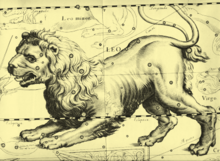
Historically, stars have been important to civilizations throughout the world. They have been part of religious practices and for celestial navigation and orientation. Many ancient astronomers believed that stars were permanently affixed to a heavenly sphere, and that they were immutable. By convention, astronomers grouped stars into constellations and used them to track the motions of the planets and the inferred position of the Sun.The motion of the Sun against the background stars (and the horizon) was used to create calendars, which could be used to regulate agricultural practices. The Gregorian calendar, currently used nearly everywhere in the world, is a solar calendar based on the angle of the Earth's rotational axis relative to the nearest star, the Sun.
The oldest accurately dated star chart appeared in Ancient Egypt in 1,534 BCE. The Greek astronomer Aristillus created the first star catalogue in approximately 300 BC, with the help of Timocharis.Ptolemy's star catalogue was based on an earlier records by Hipparchus from the 2nd century BC.Hipparchus is known for the discovery of the first nova (new star).Islamic astronomers gave to many stars Arabic names which are still used today, and they invented numerous astronomical instruments which could compute the positions of the stars. In the 11th century, Abū Rayhān al-Bīrūnī described the Milky Way galaxy as multitude of fragments having the properties of nebulous stars, and also gave the latitudes of various stars during a lunar eclipse in 1019.
The Italian astronomer Geminiano Montanari recorded observing variations in luminosity of the star Algol in 1667. Edmond Halley published the first measurements of the proper motion of a pair of nearby "fixed" stars, demonstrating that they had changed positions from the time of the ancient Greek astronomers Ptolemy and Hipparchus. The first direct measurement of the distance to a star (61 Cygni at 11.4 light-years) was made in 1838 by Friedrich Bessel using the parallax technique. Parallax measurements demonstrated the vast separation of the stars in the heavens.
William Herschel was the first astronomer to attempt to determine the distribution of stars in the sky. During the 1780s, he performed a series of gauges in 600 directions, and counted the stars observed along each line of sight. From this he deduced that the number of stars steadily increased toward one side of the sky, in the direction of the Milky Way core. His son John Herschel repeated this study in the southern hemisphere and found a corresponding increase in the same direction. In addition to his other accomplishments, William Herschel is also noted for his discovery that some stars do not merely lie along the same line of sight, but are also physical companions that form binary star systems.
The science of stellar spectroscopy was pioneered by Joseph von Fraunhofer and Angelo Secchi. By comparing the spectra of stars such as Sirius to the Sun, they found differences in the strength and number of their absorption lines—the dark lines in a stellar spectra due to the absorption of specific frequencies by the atmosphere. In 1865 Secchi began classifying stars into spectral types.However, the modern version of the stellar classification scheme was developed by Annie J. Cannon during the 1900s.
Observation of double stars gained increasing importance during the 19th century. In 1834, Friedrich Bessel observed changes in the proper motion of the star Sirius, and inferred a hidden companion. Edward Pickering discovered the first spectroscopic binary in 1899 when he observed the periodic splitting of the spectral lines of the star Mizar in a 104 day period. Detailed observations of many binary star systems were collected by astronomers such as William Struve and S. W. Burnham, allowing the masses of stars to be determined from computation of the orbital elements. The first solution to the problem of deriving an orbit of binary stars from telescope observations was made by Felix Savary in 1827.
The twentieth century saw increasingly rapid advances in the scientific study of stars. The photograph became a valuable astronomical tool. Karl Schwarzschild discovered that the color of a star, and hence its temperature, could be determined by comparing the visual magnitude against the photographic magnitude. The development of the photoelectric photometer allowed very precise measurements of magnitude at multiple wavelength intervals. In 1921 Albert A. Michelson made the first measurements of a stellar diameter using an interferometer on the Hooker telescope.
Important conceptual work on the physical basis of stars occurred during the first decades of the twentieth century. In 1913, the Hertzsprung-Russell diagram was developed, propelling the astrophysical study of stars. Successful models were developed to explain the interiors of stars and stellar evolution. The spectra of stars were also successfully explained through advances in quantum physics. This allowed the chemical composition of the stellar atmosphere to be determined.
With the exception of supernovae, individual stars have primarily been observed in our Local Group of galaxies, and especially in the visible part of the Milky Way (as demonstrated by the detailed star catalogues available for our galaxy. But some stars have been observed in the M100 galaxy of the Virgo Cluster, about 100 million light years from the Earth.[24] In the Local Supercluster it is possible to see star clusters, and current telescopes could in principle observe faint individual stars in the Local Cluster—the most distant stars resolved have up to hundred million light years away (see Cepheids). However, outside the Local Supercluster of galaxies, neither individual stars nor clusters of stars have been observed. The only exception is a faint image of a large star cluster containing hundreds of thousands of stars located one billion light years away—ten times the distance of the most distant star cluster previously observed.

No comments:
Post a Comment